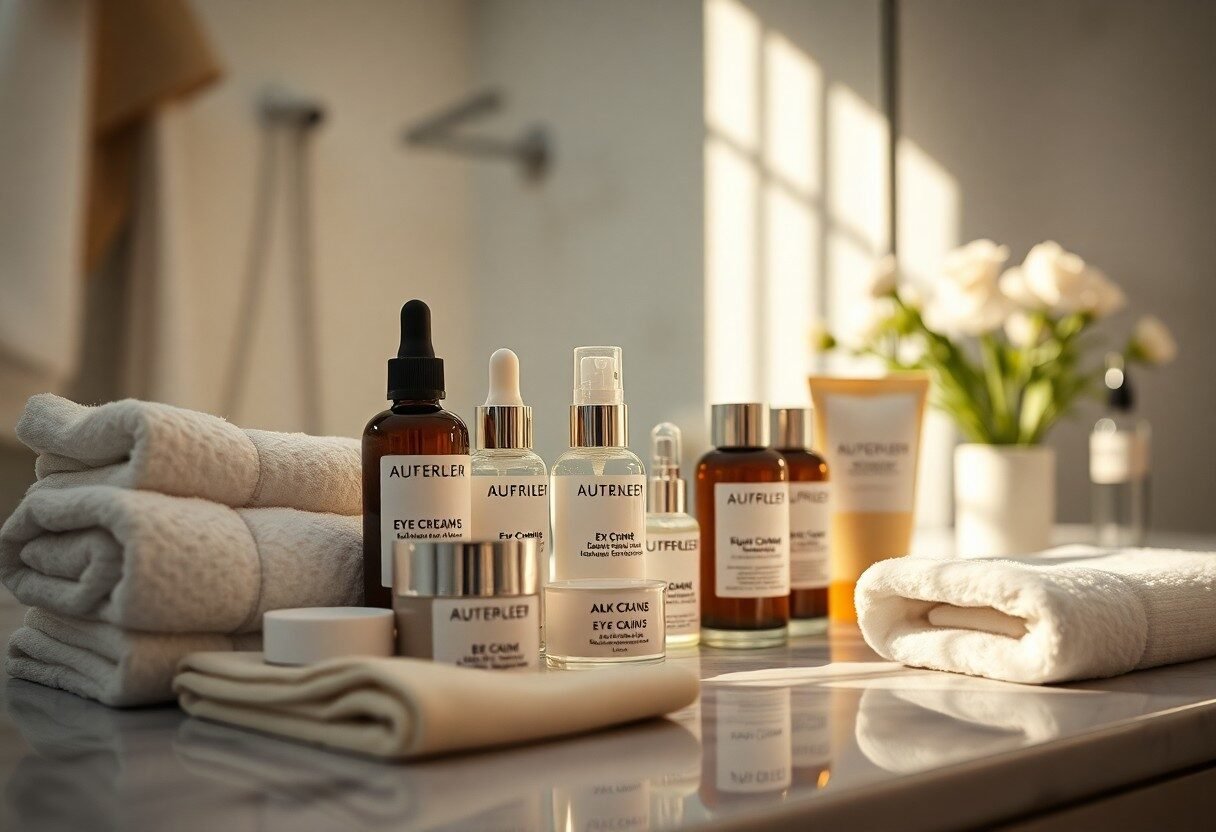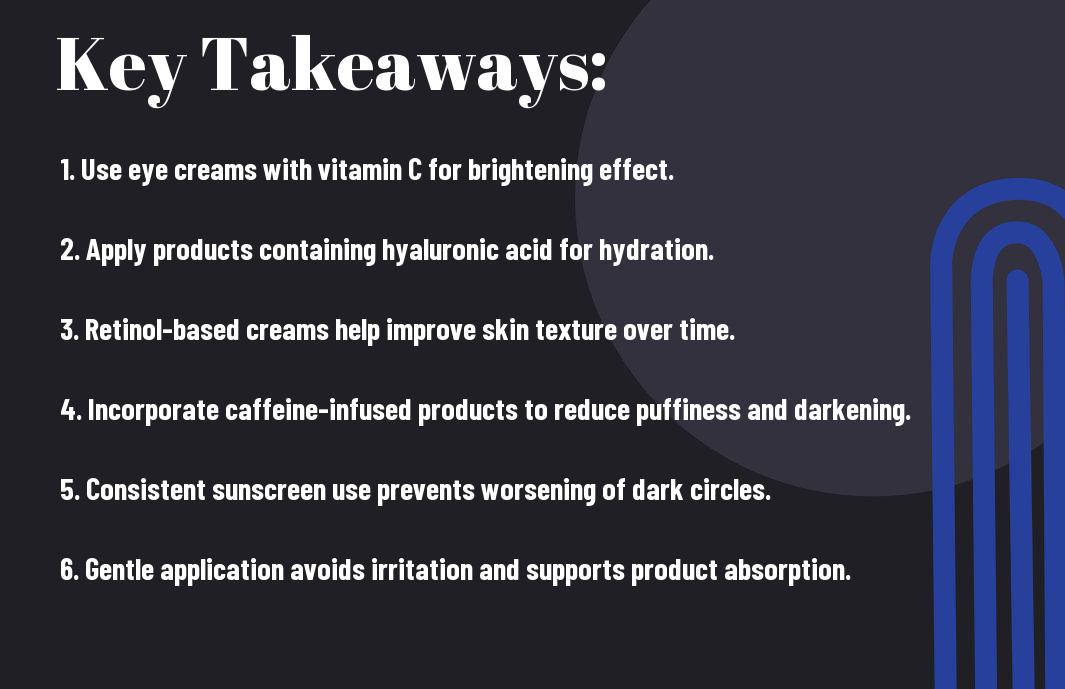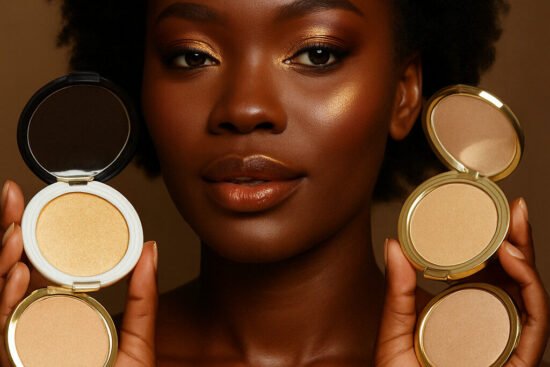
With persistent dark circles under my eyes, I know firsthand how frustrating they can be. I want to share with you some effective strategies that utilize targeted skincare products to brighten and rejuvenate your under-eye area. From potent ingredients to simple application techniques, I’ll guide you through understanding what works best for your skin type. Incorporating these methods into your daily routine can lead to a noticeable reduction in those stubborn shadows, helping you achieve a brighter, more refreshed appearance.

Key Takeaways:
- Look for ingredients like caffeine, which can help constrict blood vessels and reduce puffiness around the eyes.
- Hyaluronic acid is beneficial for hydrating the skin, making it appear plumper and helping to diminish the appearance of dark circles.
- Vitamin C is effective in brightening the skin and reducing pigmentation, making it a valuable addition to your skincare routine.
- Retinol can promote cell turnover and strengthen the skin, which can help improve the appearance of dark circles over time.
- Consider using products with peptides, as they can help to improve skin elasticity and reduce dark circles.
- Sunscreen is imperative; protecting the delicate skin around the eyes from UV damage can prevent further pigmentation issues.
- Regularly incorporating eye creams specifically formulated for dark circles can provide targeted benefits and improve overall skin texture.

The Science of Dark Circles: What Lies Beneath
Understanding the science behind dark circles is vital for effective treatment. The skin around your eyes is particularly delicate and thin, making vessels underneath more visible. Factors like blood flow, pigmentation, and fluid retention can all contribute to the shadows you see. Additionally, conditions such as allergies or fatigue exacerbate the problem, leading to discoloration and puffiness.
Genetics and Lifestyle Factors
Your genetic makeup significantly influences your likelihood of developing dark circles. Factors such as family history, age, and ethnicity can predispose you to this concern. Lifestyle habits, including poor dieting, smoking, and lack of sleep, also play an important role.
- Genetics – Family history can be a major contributor
- Aging – Natural aging processes make the skin thinner
- Lifestyle – Poor sleep and diet further worsen discoloration
Any of these factors can lead to the appearance of dark circles, making treatment more complex.
The Role of Skin Aging
As you age, your skin undergoes various changes that can make dark circles more prominent. This includes reduced collagen production, decreased elasticity, and a thinning dermis, which exposes blood vessels more readily. Additionally, fat pads under the eyes start to diminish, leading to a hollow appearance that increases shadowing. Maintaining a robust skincare routine and engaging in preventative measures can mitigate these natural processes.
The aging process impacts the delicate skin around your eyes significantly. Over time, collagen levels deplete, contributing to a loss of firmness and elasticity. This means that the skin loses its ability to bounce back, making those pesky dark circles more visible. Aged skin is also prone to pigmentation, which can further exacerbate their appearance. I often recommend incorporating products with retinol or peptides to help rejuvenate your under-eye area. These ingredients stimulate collagen production and thicken the skin, enhancing its resilience against the effects of aging and promoting a more youthful look.
Targeted Ingredients: The Power Players in Skincare
In the quest to combat dark circles, harnessing the right targeted ingredients can make all the difference. Certain compounds not only address discoloration but also enhance skin texture and hydration, transforming your undereye area. To effectively tackle dark circles, look for products with specialized actives such as caffeine, vitamin C, and hyaluronic acid, which deliver potent benefits tailored for this delicate skin. Each ingredient plays a unique role in rejuvenating tired eyes and restoring a refreshed appearance.
Caffeine: A Wake-Up Call for Tired Eyes
Caffeine is a game-changer in the fight against dark circles, offering an invigorating effect on tired eyes. It constricts blood vessels, thereby minimizing puffiness and redness. When applied topically, this stimulant not only energizes the skin but also improves circulation, resulting in a brighter, more alert look. I often recommend incorporating an eye cream with caffeine for a refreshing morning boost.
Vitamin C: Brightening and Revitalizing the Undereye Area
Vitamin C proves to be incredibly effective in brightening the undereye area. Known for its antioxidant properties, this vitamin helps combat free radical damage while promoting collagen production. The result is brighter skin and a more youthful appearance. Vitamin C also evens out skin tone, reducing the appearance of dark pigmentation and ensuring your eyes look lively again.
Integrating vitamin C into your skincare routine can dramatically enhance the quality of your undereye skin. Studies show that regular use of vitamin C can significantly lighten dark circles and improve texture. Products with a stable form of vitamin C, such as ascorbic acid, are ideal for achieving the best results. Look for formulations designed to be gentle on the sensitive skin around your eyes, allowing you to enjoy the brightening effects without irritation.
Hyaluronic Acid: Hydration for Plump Skin
Hyaluronic acid acts as a powerful humectant, drawing moisture into the skin and providing vital hydration. This is particularly beneficial for the delicate undereye area, where dryness can exacerbate the visibility of dark circles. With consistent use of hyaluronic acid, you can expect plumper, more hydrated skin that appears rejuvenated and healthy.
Using products rich in hyaluronic acid can profoundly impact your skin’s appearance. This ingredient has the unique ability to retain up to 1,000 times its weight in water, ensuring that the skin remains supple and elastic. When the undereye area is well-hydrated, fine lines and shadows become less pronounced, leading to a fresher, more vibrant look. Incorporate eye creams or serums that feature hyaluronic acid as a staple in your skincare routine for optimal results.
Formulations That Make a Difference
With a plethora of skincare products available, choosing the right formulation can significantly impact your battle against dark circles. Look for products containing a blend of ingredients like vitamin C, caffeine, and hyaluronic acid which can brighten, de-puff, and hydrate the delicate under-eye area. Additionally, formulations that incorporate peptides can help improve skin elasticity, while those with retinol may promote collagen production over time. Tailoring your product choice to your specific concerns will allow you to address dark circles more effectively.
Eye Creams vs. Serums: What’s the Best Choice?
Choosing between eye creams and serums hinges upon your skin’s unique needs. Eye creams typically offer richer, more moisturizing textures, which can be beneficial for those combatting dryness and looking for hydration. On the other hand, serums tend to feature more concentrated active ingredients, making them suitable for targeted treatment of specific concerns like pigmentation or puffiness. Understanding your skin type and the primary issues you face can guide your choice in selecting the most effective product.
The Importance of Consistency in Application
Consistency in using your chosen skincare products is important for seeing noticeable results in your fight against dark circles. Applying your eye cream or serum daily, ideally twice a day, allows the active ingredients to build up over time, maximizing their effectiveness. Skipping days or applying inconsistently might lead to sluggish performance and ultimately prolong the time it takes to see improvements. Incorporating it into your daily routine ensures that you’re nurturing your skin regularly, creating a habit that contributes to healthier, more youthful-looking eyes.
Incorporating a dedicated routine helps reinforce the benefits of your treatment. For example, using an eye cream consistently for at least four to six weeks allows bioactive compounds to penetrate deeply and deliver results, whether in the form of reduced puffiness or increased brightness. If you apply products sporadically, the effectiveness diminishes significantly, leaving you feeling frustrated with the lack of progress. Establishing a steady regimen not only enhances your results but also cultivates a self-care ritual that can improve your overall skin health.
Beyond Skincare: Complementary Practices for Lasting Results
While targeted skincare products play a significant role in reducing dark circles, incorporating complementary practices can enhance and sustain your efforts. Simple lifestyle changes can greatly contribute to the health of your skin around the eyes and elevate the overall results of your skincare routine. These practices, such as improved sleep hygiene and mindful dietary choices, are often overlooked yet can profoundly affect the appearance and vitality of your skin.
Sleep Hygiene: The Underrated Factor
Sleep hygiene significantly impacts under-eye circles and overall skin health. Aiming for 7 to 9 hours of quality sleep each night allows your skin to repair and regenerate. Prioritizing a consistent sleep schedule and creating a restful environment enhance restorative sleep. Incorporating relaxing activities before bedtime, like reading or gentle meditation, can further improve sleep quality and, in turn, help reduce the visibility of dark circles.
Hydration and Nutrition: Fueling Your Skin from Within
Hydration and nutrition are fundamental to maintaining vibrant skin. Drinking enough water—around 2 liters daily—keeps skin plump and reduces the appearance of dark circles. A diet rich in antioxidants, vitamins C and E, and omega-3 fatty acids not only supports skin health but can also combat inflammation. Foods like berries, leafy greens, nuts, and fatty fish should be staples in your meals to bolster collagen production and enhance your skin’s resilience.
Incorporating nutrient-dense foods into your daily regimen can work wonders for your overall skin health. For instance, vitamin C-rich foods like oranges and bell peppers provide necessary building blocks for collagen, helping to improve skin elasticity. Furthermore, omega-3 fatty acids found in walnuts and salmon can reduce inflammation, potentially minimizing the severity of dark circles. Staying adequately hydrated through water and herbal teas ensures your skin retains moisture, further enhancing its appearance and keeping dark circles at bay.
Expert Tips and Tricks for Immediate Impact
For a quick fix to those pesky dark circles, I often turn to these expert tips. Start with a cold compress or chilled spoons placed under the eyes for 10 minutes to reduce puffiness. A brightening concealer with yellow undertones can counteract darkness effectively. I also recommend using an eye cream with caffeine to instantly invigorate tired eyes. To maximize results, apply products with gentle tapping motions. You can also try these methods:
- Use eye patches for immediate hydration and luminosity.
- Incorporate a primer under concealer to enhance staying power.
- Experiment with color correctors for a flawless base.
This combination of techniques can yield significant improvements in the appearance of dark circles.
Makeup Techniques for Camouflaging Dark Circles
Using the right makeup techniques can drastically improve how dark circles appear. I apply a lightweight, hydrating concealer specifically designed for under-eye use, opting for formulas with brightening properties. Layering a peach-toned color corrector beneath can neutralize purple or blue hues, enhancing the concealment. Utilizing a damp beauty sponge for blending helps achieve a seamless finish, while setting everything with a fine translucent powder ensures longevity and prevents creasing. This approach provides a well-rested look despite late nights.
The Right Tools: Eye Massagers and Cooling Gels
Eye massagers and cooling gels offer a unique way to enhance your skincare routine and combat dark circles effectively. Devices like jade rollers or electronic eye massagers stimulate circulation, promoting lymphatic drainage to reduce puffiness. I’ve found that applying a gel infused with hyaluronic acid or peptides before using these tools amplifies their effects, as these ingredients hydrate and plump the skin. Regular usage can provide a soothing sensation, particularly after a long day, while the cooling element of these gels helps diminish swelling instantly.
To wrap up
To wrap up, addressing dark circles effectively requires a tailored approach using quality skincare products. I recommend incorporating ingredients like caffeine, hyaluronic acid, and vitamin C into your routine. These not only help to brighten the under-eye area but also promote hydration and reduce puffiness. Regular application of these products can lead to noticeable improvements. Ultimately, consistency is key, so make sure you incorporate these treatments into your daily regimen for the best results. Investing time in your skincare will not only enhance your appearance but also boost your confidence.
FAQ
Q: What are dark circles and what causes them?
A: Dark circles are the dark or discolored skin that appears under the eyes. They can be caused by various factors including genetics, lack of sleep, aging, dehydration, and lifestyle habits such as excessive alcohol consumption or smoking. Allergies and certain medical conditions can also contribute to the appearance of dark circles.
Q: Which skincare ingredients are most effective for treating dark circles?
A: Certain ingredients are known to be effective in reducing the appearance of dark circles. Look for skincare products containing caffeine, hyaluronic acid, vitamin C, retinol, peptides, and niacinamide. These ingredients can help to improve circulation, boost collagen production, and hydrate the skin, making it look more refreshed.
Q: How often should I apply skincare products to treat dark circles?
A: It’s generally recommended to apply targeted treatments for dark circles twice daily, once in the morning and once at night. Consistency is important for seeing results, so incorporating these products into your daily skincare routine is beneficial.
Q: Can lifestyle changes help reduce the appearance of dark circles?
A: Yes, making certain lifestyle changes can significantly help in reducing dark circles. Ensure you get sufficient sleep, stay hydrated, eat a balanced diet rich in vitamins and minerals, and engage in stress-reducing activities. Additionally, limiting caffeine and alcohol consumption can also promote healthier-looking skin.
Q: Are there specific products recommended for sensitive skin types to treat dark circles?
A: For sensitive skin types, it’s vital to choose products that are fragrance-free and formulated for delicate skin. Look for gentle ingredients such as chamomile, aloe vera, and green tea extract. Always perform a patch test before fully applying any new skincare product to avoid irritation.
Q: How long will it take to see results from using skincare products for dark circles?
A: The time it takes to see results can vary depending on the individual and the specific products being used. Generally, it may take several weeks of consistent application to notice improvements. Patience and consistency are key, as some products may take longer to show visible effects.
Q: In addition to skincare products, are there other treatments for dark circles?
A: Yes, in addition to topical products, there are various treatments available for dark circles such as chemical peels, laser therapy, and dermal fillers. These procedures are usually performed by a dermatologist or licensed professional. It’s advisable to consult a skincare expert to discuss your options and determine the best approach for your specific concerns.











